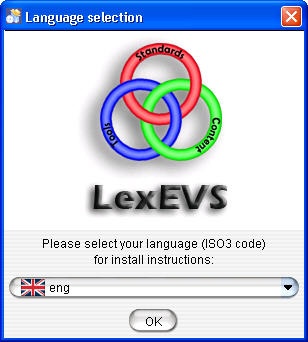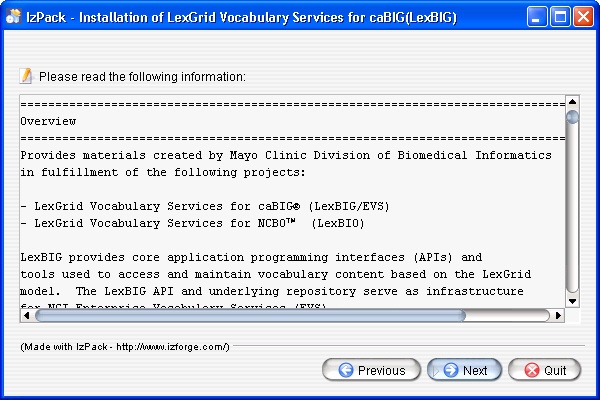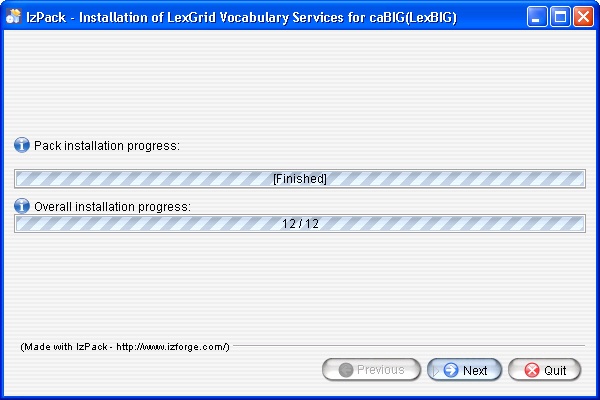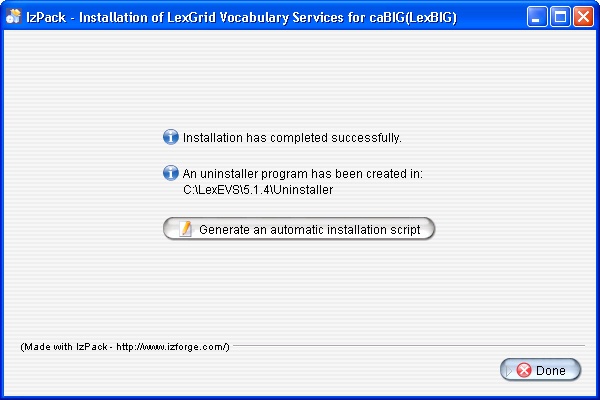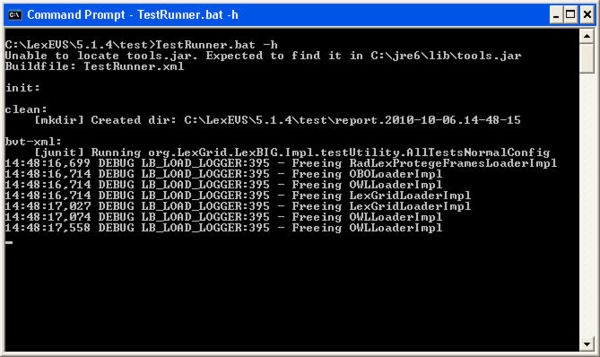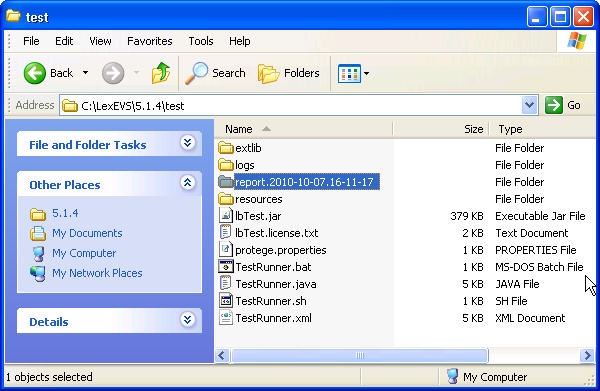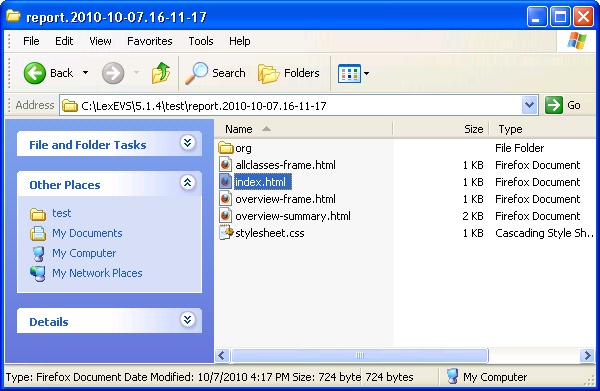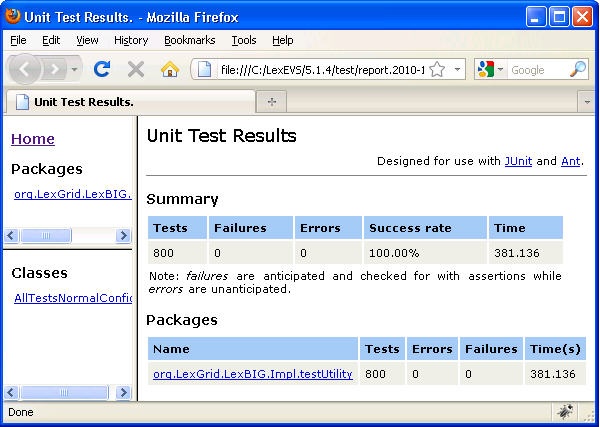 |
Page History
| Wiki Markup |
|---|
{scrollbar:icons=false}
h1. { |
| Page info |
|---|
...
|
| Panel | ||||
|---|---|---|---|---|
| ||||
|
Introduction
This document is a subsection of the Installation Guide.
This section provides requirements, instructions, and troubleshooting information for installing a LexEVS Local Runtime.
Preliminary Considerations
| Warning | ||
|---|---|---|
| ||
LexEVS has been tested with the operating systems and hardware specified in the LexEVS 5.x Supported Platforms]. While LexEVS is expected to run on many variations of hardware and software similar to the test platforms, results cannot be guaranteed. Before you begin you should check to make sure that your platform will support the software. |
- There are a number of LexEVS 5.x Prerequisite Software Supported products that you must install to run a LexEVS Local Runtime on your platform. You must make sure that you have the proper software and versions, depending on which LexEVS environment you are installing. Do this now, for the Local Runtime designated prerequisite software, before continuing to the install steps.
- As an option you may consider the command line install of a LexEVS Local Runtime for putting all the necessary files in place based on a pre-decided list of components to include. As noted in the last step of the GUI Installer for LexEVS Local Runtime, you can save a file that represents the choices you have made during the GUI install. This file can be used as-is or be edited and then fed into an install on another server. Follow the steps for 6 - Installing LexEVS 5.x and Higher Local Runtime (Optional Command Line Method) if you should choose this route.
- Complete the #Downloading and Installing the LexEVS Local Runtime steps below.
Once you have completed the prerequisite software install, the Local Runtime environment install steps, and the verification test as described in this guide then you should be ready to start programming using the API to meet the needs of your application. Not counting prerequisite software products the installation and verification should not take more than 60 minutes.
Downloading and Installing the LexEVS Local Runtime
Step | Action | |||||||||||
|---|---|---|---|---|---|---|---|---|---|---|---|---|
1. Download the latest version of the Local Runtime GUI install package from the right. The location you have chosen to save this on your computer will be referred to as the
|
| |||||||||||
2. Using a file explorer, navigate to the
|
...
Then |
...
enter |
...
the |
...
command |
...
to |
...
begin |
...
the |
...
installation |
...
wizard: |
...
|
...
|
...
...where |
...
|
...
is |
...
the |
...
version |
...
you |
...
downloaded |
...
|
...
example: |
...
|
...
|
...
| |||||||||||
3. Click the OK button to begin the installation.
|
| ||||||||||
4. After the initial welcome screen, the release notes for the LexEVS distribution are displayed. Once you have read through the release notes click the Next button. |
| ||||||||||
5. Review the license agreement of the LexEVS software. Select "I accept the terms of this license agreement." and click Next. |
| ||||||||||
6. Enter the path where you would like the LexEVS software installed. This will be referred to as
Click the Next button.
|
| ||||||||||
7. Select the components to be installed. The components "Product Information" and "Runtime and Administration Toolkit" are required and cannot be unchecked. The remaining components are optional. Clicking on individual components will display a description of that component. |
| ||||||||||
8. Once all the components have been installed, a Finished dialog box will be displayed. Click Next. |
| ||||||||||
9. The last step of the installation wizard provides the ability to generate a command line installation configuration XML file that can be used on other servers. This installation script can be used to install LexEVS without the wizard that you just went through. If you want to generate this file then click the Generate an automatic installation script button. This will have no effect on the current installation. For more information look at the optional #Downloading and Installing the LexEVS Local Runtime. |
|
What's Inside
This section describes the location and organization of installation materials. Following installation, many of the following hierarchy of files and directories will be available (some features are optionally installable):
(As located in the LexEVS installation root directory)
Directory | Description of Content | |||||
|---|---|---|---|---|---|---|
/admin | Installed by default. This directory provides a centralized point for command line scripts that can be executed to perform administrative functions such as the loading, activation/deactivation, and removal of vocabulary resources. | |||||
/doc | Optionally installed. This directory provides documentation related to LexEVS services, configuration, and execution. This guide is distributed in the /doc top-level directory. | |||||
/doc/javadoc | This directory provides documentation for model classes and public interfaces available to LexEVS programmers. Also included with each object representation is a UML-based model diagram that shows the object, its attributes and operations, and immediately linked objects. The diagrams work to provide clickable navigation through the javadoc materials | |||||
/examples | Optionally installed. This directory provides a small number of example programs. | |||||
/examples/resources | Contains sample vocabulary content for reference by the example programs; use the /examples/LoadSampleData command-line script to load for example code use or use one of the loaders in the /admin folder to load other content. | |||||
/gui | Optionally installed. This folder contains programs and supporting files to launch the LexEVS Graphical User Interface (GUI). The GUI provides convenient centralized access to administrative functions as well as support to test and exercise most of the LexEVS API. | |||||
/logs | Default location for log files, which can be modified by the | |||||
/resources | Installed by default. This directory contains resources referenced and written directly by the LexEVS runtime. It should, in general, be considered off-limits to modify or remove the content of this directory without specific guidance and reason to do so. Files typically stored to this location include the vocabulary registry (tracking certain metadata for installed content) and indexes used to facilitate query over the installed content. | |||||
/runtime | Installed by default. This directory contains a Java archive (.jar) file containing the combined object code of the LexEVS runtime, LexEVS administrative interfaces, and any additional code they are dependent on. All required code for execution of LexEVS administrative and runtime services is installed to this directory.
| |||||
/runtime/sqldrivers | The JDBC drivers used to connect to database repositories are not included in the lbRuntime.jar. Instead, the runtime scans this directory for the drivers to include. This can be overridden by path settings in the lbconfig.props file.
For example, the Oracle database is supported by the runtime environment. However, the drivers are not redistributed with the LexEVS software. To run against Oracle, an administrator would add a jar with the appropriate JDBC driver to this directory and then reference it in the lbconfig.props settings. MySQL, the main test base for LexEVS, also requires a restricted license driver. It's driver can be downloaded here: mysql-connector-java-5.1.6. |
...
/runtime-components |
...
Optionally |
...
installed. |
...
Due |
...
to |
...
license |
...
considerations |
...
for |
...
additional |
...
materials |
...
(as |
...
described |
...
by |
...
the |
...
license.pdf |
...
and |
...
license.txt |
...
files |
...
in |
...
the |
...
install |
...
directory), |
...
the |
...
cumulative |
...
runtime |
...
provided |
...
in |
...
the |
...
lbRuntime.jar |
...
is |
...
not |
...
redistributable. |
...
|
...
directory |
...
contains |
...
a |
...
finer |
...
grain |
...
breakdown |
...
of |
...
object |
...
code |
...
into |
...
logical |
...
components |
...
and |
...
3rd |
...
party |
...
inclusions. |
...
All |
...
components |
...
are |
...
redistributable |
...
under |
...
their |
...
own |
...
license |
...
agreements, |
...
which |
...
are |
...
provided |
...
along |
...
with |
...
each |
...
archive. |
...
|
...
top-level |
...
of |
...
the |
...
/runtime-components |
...
directory |
...
contains |
...
all |
...
code |
...
produced |
...
for |
...
the |
...
LexEVS |
...
project |
...
in |
...
the |
...
lexbig.jar. |
...
|
...
|
...
|
...
|
...
|
...
|
...
|
...
|
...
|
...
|
...
|
...
|
...
|
...
|
...
|
...
|
...
|
...
|
...
|
...
|
...
|
...
|
...
|
...
|
...
|
...
|
...
|
...
|
...
|
...
|
...
|
...
|
...
|
...
|
...
|
...
|
...
|
...
|
...
|
...
|
...
|
...
|
...
|
...
/runtime- |
...
|
...
|
...
This |
...
subdirectory |
...
includes |
...
all |
...
3rd |
...
party |
...
code |
...
redistributed |
...
with |
...
the |
...
LexEVS |
...
runtime, |
...
along |
...
with |
...
respective |
...
license |
...
agreements. |
...
/source |
...
Optionally |
...
installed. |
...
This |
...
directory |
...
provides |
...
central |
...
accessibility |
...
to |
...
Java |
...
source |
...
for |
...
all |
...
code |
...
developed |
...
for |
...
the |
...
LexEVS |
...
project. |
...
/test |
...
Optionally |
...
installed. |
...
This |
...
directory |
...
provides |
...
an |
...
automated |
...
test |
...
bucket |
...
that |
...
can |
...
be |
...
used |
...
by |
...
System |
...
Administrators |
...
to |
...
verify |
...
node |
...
installation. |
...
Note |
...
that |
...
the |
...
/runtime/config/lbconfig.props |
...
file |
...
must |
...
still |
...
be |
...
configured |
...
for |
...
database |
...
access |
...
prior |
...
to |
...
invoking |
...
the |
...
test |
...
bucket. |
...
|
...
are |
...
launched |
...
via |
...
the |
...
TestRunner |
...
command-line |
...
script. |
...
Several |
...
reporting |
...
options |
...
are |
...
provided |
...
and |
...
are |
...
further |
...
described |
...
in |
...
the |
...
LexEVS |
...
Administrator's |
...
Guide |
...
. |
...
/uninstaller |
...
Contains |
...
an |
...
executable |
...
jar |
...
that |
...
can |
...
be |
...
invoked |
...
by |
...
an |
...
administrator |
...
to |
...
uninstall |
...
files |
...
originally |
...
introduced |
...
by |
...
the |
...
LexEVS |
...
installation. |
...
Configuring the LexEVS Environment
The LexEVS Local Runtime can be configured to work with many different databases, however, the recommended databases are MySQL or PostgreSQL as noted in LexEVS 5.x Prerequisite Software Supported. Following installation of a database of your choice you should follow these steps in order. The remaining text in this section is meant to help facilitate these steps.
- Configure properties of your database software (MySQL and PostgreSQL examples shown below)
- Create a database (commands for this are available in your database software documentation)
- Obtain a JDBC driver for LexEVS to use when accessing the database.
- Check {LEXEVS_HOME}\runtime\sqlDrivers to see if the appropriate driver for your database is there. Due to licensing reasons we can not ship some drivers, such as the MySQL driver.
- MySQL driver can be downloaded from Mysql driver mysql-connector 5.1.6.
- Check {LEXEVS_HOME}\runtime\sqlDrivers to see if the appropriate driver for your database is there. Due to licensing reasons we can not ship some drivers, such as the MySQL driver.
- Update the LexEVS lbconfig.props file (server properties) with connection and database settings
| Info | ||
|---|---|---|
| ||
It is considered beyond the scope of these install instructions to address database setup and administration. However, proper database configuration is critical to the performance and long-term health of the LexEVS environment. |
MySQL Properties
At a minimum you should consider changing these properties controlling the behavior of the MySQL database server. These properties are usually located in the file {MYSQL_HOME}/my.ini.
Property Name | Description |
|---|---|
innodb_flush_log_at_trx_commit |
...
Flush |
...
the |
...
transaction |
...
logs |
...
at |
...
each |
...
commit. |
...
|
...
It |
...
is |
...
highly |
...
recommended |
...
that |
...
this |
...
option |
...
be |
...
set |
...
to |
...
'0' |
...
in |
...
Windows |
...
installations |
...
to |
...
improve |
...
load |
...
performance. |
...
innodb_additional_mem_pool_size |
...
Additional |
...
memory |
...
pool |
...
that |
...
is |
...
used |
...
by |
...
InnoDB |
...
to |
...
store |
...
metadata |
...
information. |
...
|
...
16M |
...
innodb_buffer_pool_size |
...
Buffer |
...
pool |
...
used |
...
to |
...
cache |
...
both |
...
indexes |
...
and |
...
row |
...
data. |
...
|
...
1G |
...
(consider |
...
going |
...
higher |
...
based |
...
on |
...
physical |
...
RAM |
...
available) |
...
tmp_table_size |
...
Maximum |
...
size |
...
for |
...
internal |
...
(in-memory) |
...
temporary |
...
tables. |
...
|
...
256M |
...
query_cache_size |
...
Query |
...
cache |
...
is |
...
used |
...
to |
...
cache |
...
SELECT |
...
results |
...
and |
...
later |
...
return |
...
them |
...
without |
...
actually |
...
executing |
...
the |
...
same |
...
query |
...
once |
...
again. |
...
|
...
64M |
...
sort_buffer_size |
...
This |
...
buffer |
...
is |
...
allocated |
...
when |
...
MySQL |
...
needs |
...
to |
...
rebuild |
...
the |
...
index |
...
in |
...
REPAIR, |
...
OPTIMZE, |
...
ALTER |
...
table |
...
statements |
...
as |
...
well |
...
as |
...
in |
...
LOAD |
...
DATA |
...
INFILE |
...
into |
...
an |
...
empty |
...
table. |
...
|
...
16M |
| Info | ||
|---|---|---|
| ||
MySQL can be passed a JDBC option for the Windows local environment that may improve perfomance 30 to 50%. |
Try the following values in the lbconfig.props file for the DB_URL. This uses Windows Named Pipe function and avoids use of the TCP/IP protocol. It only works when connecting with a local iteration of the MySQL database on Windows.
| Code Block |
|---|
| {info:title=Note}MySQL can be passed a JDBC option for the Windows local environment that may improve perfomance 30 to 50%.{info} Try the following values in the lbconfig.props file for the DB_URL. This uses Windows Named Pipe function and avoids use of the TCP/IP protocol. It only works when connecting with a local iteration of the MySQL database on Windows. {code} DB_URL=jdbc:mysql:///<dbname>?socketFactory=com.mysql.jdbc.NamedPipeSocketFactory {code} |
There
...
are
...
some
...
commands
...
that
...
we
...
have
...
found
...
useful
...
in
...
this
...
environment.
...
You
...
can
...
investigate
...
this
...
database
...
software
...
more
...
at
...
the
...
...
...
site.
If you have root or administrator access to your server you can change the password for the root user ID if you have forgotten or lost it.
| Code Block |
|---|
|http://dev.mysql.com/doc/]. If you have root or administrator access to your server you can change the password for the root user ID if you have forgotten or lost it. {code} mysqladmin -u root password \{mypassword\} {code} |
...where
...
mypassword
...
is
...
your
...
new
...
password
...
Creating
...
a
...
database
...
within
...
the
...
software
...
can
...
be
...
done
...
via
...
the
...
command
...
line.
...
The
...
software
...
does
...
not
...
come,
...
by
...
default,
...
with
...
GUI
...
administration.
...
That
...
command
...
might
...
look
...
like
...
this:
| Code Block |
|---|
} mysqladmin -u root -p create \{DBNAME\} {code} |
...where
...
DBNAME
...
is
...
the
...
name
...
of
...
your
...
database
...
needed
...
for
...
LexEVS
...
to
...
store
...
data
...
in.
...
You
...
will
...
be
...
prompted
...
for
...
your
...
password
...
before
...
the
...
database
...
is
...
created.
...
PostgreSQL
...
Properties
...
-
...
Modifying
...
the
...
posgresql.conf
...
File
...
for
...
PostgreSQL
...
The
...
following
...
file
...
contains
...
properties
...
controlling
...
the
...
behavior
...
of
...
the
...
PostgreSQL
...
database
...
server:
| Code Block |
|---|
} PostgreSQL_HOME_DIRECTORY}/posgresql.conf {code} || Property Name || Description || | |
Property Name | Description |
|---|---|
shared_buffers |
...
Number |
...
of |
...
shared |
...
buffers. |
...
|
...
1000. |
...
work_mem |
...
The |
...
amount |
...
of |
...
memory |
...
in |
...
kilobytes |
...
allocated |
...
to |
...
working |
...
memory |
...
|
...
51200. |
...
maintenance_work_mem |
...
The |
...
amount |
...
of |
...
memory |
...
in |
...
kilobytes |
...
allocated |
...
to |
...
maintenance |
...
working |
...
memory. |
...
|
...
512000. |
...
enable_seqscan |
...
We |
...
set |
...
the |
...
|
...
to |
...
false |
...
to |
...
use |
...
always |
...
use |
...
an |
...
index |
...
versus |
...
a |
...
table |
...
scan. |
...
Server Properties
The next step is to configure LexEVS. This is wrapped up in editing one file, {LEXEVS_HOME
...
}/resources/config/lbconfig.props.
...
This
...
file
...
contains
...
properties
...
controlling
...
the
...
behavior
...
of
...
the
...
LexEVS
...
Local
...
Runtime.
| Warning | ||||
|---|---|---|---|---|
| =
| |||
| } The lbconfig.props file has the latest documentation embedded inside of it. lbconfig.props should be considered authoritative if there is a difference between the documentation written here and that contained in lbconfig.props.
may open that file now and use the documentation within it to configure LexEVS and skip the rest of this section, keeping in mind that the information here is useful but not necessary to a successful install. {warning} |
Below
...
you
...
will
...
find
...
an
...
expanded
...
overview
...
of
...
the
...
options
...
in
...
this
...
file.
...
Options
...
in
...
BOLD
...
must
...
be
...
modified
...
so
...
that
...
LexEVS
...
can
...
properly
...
use
...
your
...
database.
...
They
...
are
...
also
...
noted
...
as
...
required.
...
There
...
are
...
many
...
other
...
options
...
that
...
you
...
can
...
change
...
for
...
performance
...
reasons
...
or
...
alternative
...
deployment
...
scenarios,
...
but
...
you
...
probably
...
don't
...
need
...
to
...
change
...
them
...
in
...
a
...
standard
...
LexEVS
...
installation.
...
Some
...
options
...
can
...
not
...
be
...
changed
...
after
...
you
...
load
...
terminologies
...
into
...
LexEVS.
...
Now
...
would
...
be
...
a
...
good
...
time
...
to
...
read
...
about
...
what
...
is
...
available
...
to
...
you.
| Info | ||||
|---|---|---|---|---|
| =
| |||
| } A single back slash '\' is not valid within the lbconfig.props file for file or directory paths (except within JDBC connection strings). When constructing file or directory paths you must use either a forward slash '/ or two backward slashes ' \\
|
Property Name | Description | ||
|---|---|---|---|
DB_URL | Required: The address of your database server. This will include the host name or IP address followed by the name of the database that you created to store LexEVS data. For example:
|
...
...where |
...
|
...
is |
...
the |
...
name |
...
of |
...
your |
...
server |
...
or |
...
host |
...
|
...
|
...
is |
...
the |
...
name |
...
of |
...
the |
...
database |
...
you |
...
created |
...
for |
...
LexEVS |
...
within |
...
your |
...
database |
...
software. |
...
| |
DB_PREFIX | Required for Oracle databases: The prefix to use on all tables or databases that LexEVS creates. |
DB_PARAM | Optional variable for passing extra database parameters. These will be appended to the end of the database connection string. |
DB_DRIVER | Required: The Java class name that represents the driver that you wish to use with your database. |
DB_USER | Required: The database username. This account must have permission to add and remove tables, indexes, etc inside of this database. |
DB_PASSWORD | Required: The password for the database username. |
LG_CONFIG_FILE | This is not actually a variable that you would set within this file. It is documented here for clarity of other variables that depend on this variable. |
LG_BASE_PATH | This variable is the path that will be used to resolve any other relative (or unqualified) paths in the lbconfig.props file. |
JAR_FILE_LOCATION | The path of the folder that contains your SQL drivers and LexEVS extensions (if you have any). |
...
REGISTRY_FILE |
...
The |
...
location |
...
of |
...
the |
...
file |
...
that |
...
will |
...
store |
...
information |
...
about |
...
all |
...
loaded |
...
terminologies. |
...
|
...
value |
...
can |
...
be |
...
relative |
...
to |
...
the |
...
|
...
or |
...
absolute. |
...
|
...
default |
...
is |
...
'registry.xml' |
...
INDEX_LOCATION |
...
The |
...
folder |
...
where |
...
all |
...
LexEVS |
...
generated |
...
indexes |
...
will |
...
be |
...
stored. |
...
This |
...
folder |
...
can |
...
potentially |
...
be |
...
large |
...
(100+ |
...
GB) |
...
- |
...
depending |
...
on |
...
the |
...
terminologies |
...
loaded. |
...
|
...
value |
...
can |
...
be |
...
relative |
...
to |
...
the |
...
|
...
or |
...
absolute. |
...
|
...
default |
...
is |
...
'../lbIndex' |
...
MAX_CONNECTIONS_PER_DB |
...
LexEVS |
...
maintains |
...
a |
...
pool |
...
of |
...
connections |
...
to |
...
each |
...
database |
...
that |
...
it |
...
connects |
...
to. |
...
This |
...
sets |
...
the |
...
limit |
...
on |
...
the |
...
number |
...
of |
...
connections |
...
that |
...
will |
...
be |
...
opened. |
...
You |
...
may |
...
want |
...
to |
...
set |
...
this |
...
to |
...
a |
...
higher |
...
value |
...
- |
...
20 |
...
or |
...
so |
...
(depending |
...
on |
...
expected |
...
user |
...
load) |
...
|
...
default |
...
is |
...
8. |
...
CACHE_SIZE |
...
LexEVS |
...
maintains |
...
an |
...
internal |
...
cache |
...
of |
...
some |
...
information |
...
that |
...
it |
...
needs |
...
to |
...
query |
...
from |
...
the |
...
database |
...
to |
...
resolve |
...
queries. |
...
This |
...
controls |
...
the |
...
size |
...
of |
...
that |
...
cache. |
...
This |
...
cache |
...
does |
...
not |
...
hold |
...
entire |
...
user |
...
queries. |
...
|
...
default |
...
size |
...
is |
...
500. |
...
ITERATOR_IDLE_TIME |
...
The |
...
length |
...
of |
...
time |
...
to |
...
allow |
...
an |
...
unused |
...
(and |
...
unclosed) |
...
iterator |
...
to |
...
stay |
...
valid |
...
before |
...
it |
...
is |
...
closed |
...
(and |
...
its |
...
resources |
...
freed) |
...
by |
...
the |
...
system. |
...
|
...
default |
...
is |
...
5 |
...
minutes. |
...
MAX_RESULT_SIZE |
...
This |
...
controls |
...
the |
...
maximum |
...
number |
...
of |
...
results |
...
that |
...
a |
...
user |
...
can |
...
resolve |
...
at |
...
one |
...
time |
...
for |
...
the |
...
CodedNodeSets |
...
and |
...
CodedNodeGraphs. |
...
|
...
does |
...
not |
...
affect |
...
the |
...
total |
...
number |
...
of |
...
results |
...
that |
...
can |
...
be |
...
returned |
...
by |
...
an |
...
iterator, |
...
just |
...
the |
...
size |
...
that |
...
can |
...
be |
...
returned |
...
on |
...
the |
...
'next' |
...
API |
...
call. |
...
|
...
default |
...
is |
...
1000. |
...
LUCENE_MAX_CLAUSE_COUNT |
...
The |
...
number |
...
of |
...
boolean |
...
'clauses' |
...
Lucene |
...
will |
...
attempt |
...
to |
...
create |
...
for |
...
wildcard |
...
or |
...
Regular |
...
Expression |
...
queries. |
...
For |
...
very |
...
general |
...
queries |
...
on |
...
large |
...
ontologies, |
...
this |
...
will |
...
need |
...
to |
...
be |
...
set |
...
high. |
...
|
...
default |
...
is |
...
40000. |
...
LOG_FILE_LOCATION |
...
The |
...
path |
...
where |
...
LexEVS |
...
log |
...
files |
...
will |
...
be |
...
written. |
...
|
...
value |
...
can |
...
be |
...
relative |
...
to |
...
the |
...
|
...
or |
...
absolute. |
...
|
...
default |
...
is |
...
'../../logs' |
...
API_LOG_ENABLED |
...
Setting |
...
API |
...
call |
...
logging |
...
to |
...
'true' |
...
will |
...
cause |
...
every |
...
method |
...
call |
...
to |
...
be |
...
printed |
...
to |
...
the |
...
log |
...
file. |
...
|
...
default |
...
is |
...
'false'. |
...
SQL_LOG_ENABLED |
...
Setting |
...
SQL |
...
logging |
...
to |
...
'true' |
...
will |
...
cause |
...
every |
...
sql |
...
statement |
...
executed |
...
to |
...
be |
...
printed |
...
to |
...
the |
...
log |
...
file. |
...
|
...
default |
...
is |
...
'false'. |
...
DEBUG_ENABLE |
...
Setting |
...
debug |
...
to |
...
'true' |
...
will |
...
give |
...
you |
...
more |
...
verbose |
...
logging |
...
information |
...
to |
...
debug |
...
problems. |
...
This |
...
should |
...
normally |
...
be |
...
set |
...
to |
...
'false' |
...
since |
...
debug |
...
logging |
...
causes |
...
a |
...
negative |
...
performance |
...
impact. |
...
|
...
default |
...
is |
...
'false'. |
...
LOG_CHANGE |
...
Indicates |
...
when |
...
a |
...
new |
...
log |
...
file |
...
should |
...
be |
...
started. |
...
This |
...
can |
...
be |
...
set |
...
to |
...
'monthly', |
...
'weekly' |
...
or |
...
'daily'. |
...
|
...
can |
...
also |
...
be |
...
set |
...
to |
...
a |
...
number |
...
which |
...
will |
...
cause |
...
it |
...
to |
...
start |
...
a |
...
new |
...
log |
...
file |
...
whenever |
...
it |
...
reaches |
...
the |
...
specified |
...
number |
...
of |
...
MB |
...
in |
...
size. |
...
|
...
default |
...
is |
...
5 |
...
MB. |
...
ERASE_LOGS_AFTER |
...
If |
...
is |
...
set |
...
to |
...
'daily', |
...
'weekly', |
...
or |
...
'monthly', |
...
this |
...
variable |
...
instructs |
...
the |
...
logging |
...
service |
...
to |
...
remove |
...
log |
...
files |
...
that |
...
have |
...
not |
...
been |
...
written |
...
to |
...
in |
...
the |
...
specified |
...
amount |
...
of |
...
days. |
...
|
...
LOG_CHANGE |
...
is |
...
set |
...
to |
...
a |
...
number |
...
of |
...
MB |
...
then |
...
this |
...
variable |
...
specifies |
...
the |
...
number |
...
of |
...
old |
...
log |
...
files |
...
that |
...
will |
...
be |
...
kept. |
...
|
...
unit |
...
is |
...
treated |
...
as |
...
days |
...
regardless |
...
of |
...
the |
...
|
...
value. |
...
|
...
will |
...
only |
...
occur |
...
on |
...
restart |
...
of |
...
the |
...
JVM. |
...
|
...
default |
...
is |
...
5 |
...
files. |
...
EMAIL_ERRORS |
...
Used |
...
to |
...
enable |
...
or |
...
disable |
...
...
notification |
...
of |
...
system |
...
errors |
...
and |
...
warnings. |
...
If |
...
you |
...
set |
...
this |
...
to |
...
'true', |
...
you |
...
must |
...
set |
...
|
...
and |
...
|
...
. |
...
|
...
default |
...
is |
...
'false'. |
...
SMTP_SERVER |
...
The |
...
SMTP |
...
server |
...
to |
...
use |
...
to |
...
send |
...
errors |
...
over |
...
e-mail. |
...
|
...
applicable |
...
when |
...
|
...
is |
...
set |
...
to |
...
'true'. |
...
|
...
default |
...
value |
...
is |
...
an |
...
example |
...
that |
...
must |
...
be |
...
modified |
...
to |
...
be |
...
useful. |
...
EMAIL_TO |
...
A |
...
comma |
...
separated |
...
list |
...
of |
...
...
address |
...
to |
...
set |
...
failure |
...
and |
...
warning |
...
notifications |
...
to. |
...
|
...
applicable |
...
when |
...
|
...
is |
...
set |
...
to |
...
'true'. |
...
|
...
default |
...
value |
...
is |
...
an |
...
example |
...
that |
...
must |
...
be |
...
modified |
...
to |
...
be |
...
useful. |
...
Testing the LexEVS Local Runtime
This Local Runtime installation provides a test suite to verify the environment. Before running these tests the Local Runtime and databases must already be configured.
Step | Action | |
|---|---|---|
1. In a command prompt window change to the test directory:
|
...
...where |
...
|
...
is |
...
the |
...
extension |
...
appropriate |
...
for |
...
your |
...
operating |
...
system |
...
(bat |
...
for |
...
Windows, |
...
sh |
...
for |
...
Unix). |
...
|
...
example: |
...
|
...
|
...
|
...
|
...
|
...
|
...
|
| |||||
2. Use a file explorer to navigate into the directory that contains the test report. The report directory is placed in |
...
and |
...
is |
...
representative |
...
of |
...
the |
...
date |
...
and |
...
time |
...
you |
...
executed |
...
the |
...
test. |
|
3. Launch the report into the default browser by double-clicking on the |
|
4. Review the test results. You should expect no failures or errors if the configuration of the Local Runtime and the databases is correct. If there are errors refer to the troubleshooting section. |
|
If all the tests pass then you have successfully installed the LexEVS Local Runtime. Congratulations!
Troubleshooting
- If you use a space in the name of the path to install LexEVS, that is
LEXEVS_HOME, you might get errors from the underlying database during runtime. It it highly recommended that you do not use a space in the path. - Upgrading LexEVS may require reloading content. Be sure to read the release notes for each LexEVS release before installing the latest version. Preserve configuration files and indexes unless instructed to reload or do otherwise in the release notes. These files include
lbconfig.props, registry.xml and the entire lbIndex directory in the resources directory. Note that the names of those last two files can be altered by variables in the lbconfig.props file. - LexEVS loads of content are generally handled in a robust manner. Failed loads clean up after themselves relatively well when database management systems are properly configured to allow database drop functions by LexEVS. However, exiting the application in the middle of a load may cause unpredictable results in the databases, indexes, and lock files. They could be left in a state that will cause subsequent loads of the same terminology to fail.
- Often these can be remedied by deleting the lock.xml file followed by using the cleanup function.
- Other steps may need to be taken if this doesn't work, including dropping databases as the DBA, deleting the index file for the offending terminology, and editing the
registry.xmlandmetadata.xmlfiles by hand. - A quick, dirty solution is to drop all databases and delete all configuration files except
lbconfig.props.
- Know when to scale database management systems for a large number of connections. If LexEVS is configured for multi-database loads and has multiple users connecting to all terminologies, then the administrator will need to scale database configurations to adapt to this. If you have a large number of terminologies loaded and a large user base connecting to the service using the lbGUI, then you will need the database configuration for number of connections scaled appropriately or users may not be able to connect.
Info title Note Loading in single database mode can eliminate this problem.
- LexEVS is no longer distributed with a Java MySQL driver due to licensing concerns. If LexEVS reports an error concerning establishing a connection to the MySQL server yet the MySQL CLI is able to connect, an adjustment in the version of Connector/J may be required.
- The latest version of Connector/J is available from MySQL.org. The new jar should be placed in the following directory:
Code Block {LEXEVS_HOME}/runtime/sqlDrivers/
- The latest version of Connector/J is available from MySQL.org. The new jar should be placed in the following directory:
...
If
...
- you
...
- are
...
- changing
...
- drivers
...
- remove
...
- the
...
- existing
...
- driver
...
- jar
...
- file
...
- to
...
- ensure
...
- that
...
- the
...
- class
...
- loader
...
- does
...
- not
...
- incorrectly
...
- load
...
- the
...
- older
...
- driver
...
- file.
...
- If
...
- the
...
- user
...
- experiences
...
- slow
...
- performance
...
- with
...
- MySQL
...
- when
...
- loading
...
- or
...
- accessing
...
- terminologies
...
- then
...
- a
...
- review
...
- of
...
- the
...
- suggested
...
- configuration
...
- parameters
...
- for
...
- the
...
- database
...
- management
...
- system
...
- is
...
- recommended.
...
- Pay
...
- particular
...
- attention
...
- to
...
- the
...
- MySQL
...
- values.
| Wiki Markup |
|---|
{scrollbar:icons=false} |
